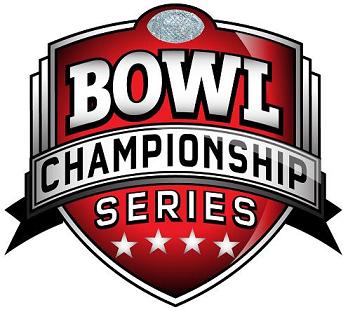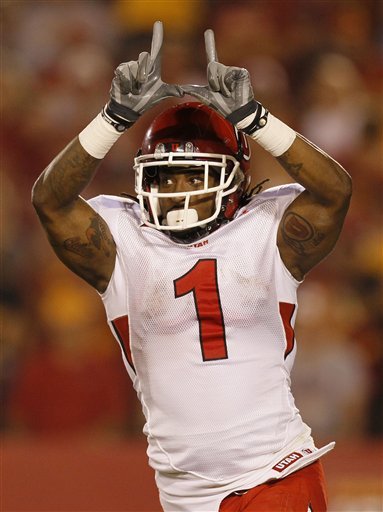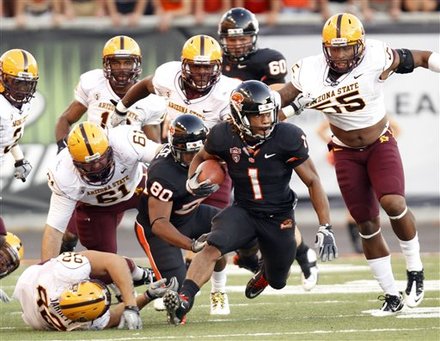The college football season is crossing its halfway point, heading into the end of October and starting to sift out the contenders from the pretenders in conference championship and National Championship races....
The illogical madness that is the BCS Standings released their first rankings this past weekend, causing a mini uproar among teams not named Oklahoma. This is understandable, but completely irrational.
If college football fans have learned anything over the past...century, it's that the post-season and final polls are not even close to being settled until the first weekend in December. Not too long ago, in 2007, we had numerous number 1's and 2's knocked off throughout the season, squeezing a 2 LOSS team into the National Championship Game.
As of now, we have 10 unbeatens in the college football world, a fairly high number for this time of year. Of those 10 unbeatens, six of them could legitimately run the table by season's end. How can we trust the BCS to possibly sort out who the top two teams are? The human poll that is taken into consideration, the Coaches Poll, is ran by people who are a little preoccupied with their jobs as coaches rather than trying to sort out who is actually playing the best football. They may have slight insight to those in their conference, but I would imagine the majority of them look at final scores at the end of the night (or the next morning) rather than analyzing the teams in detail.
Then, the computer rankings. I forgot how big of fans computers were...
I get why there is such a formula, to try and weed out bias from the human polls and use a more "scientific" approach, such as strength of schedule and quality wins. But do we really need a computer to calculate all that? Shouldn't we trust humans to take all that into consideration? As the past has shown, we definitely cannot.
A solution to this mess is needed, and better sooner than later. With ESPN taking a hold of the reigns of the BCS, they have the power to influence the major brains behind college football into changing the way the post-season is done.
First off, let's abolish the coaches poll. It's a joke; and while no one knows the game better than the coaches, they are not well equipped to help pick out our national champion.
Instead, there needs to be a committee of sorts, made up of "experts" around the country. Make sure there are equal members from the various regions in the country (West Coast, Midwest, Southeast, East Coast, etc.) and have them study the games religiously each Saturday. Then, on Sunday, have them meet in a room and discuss the previous days events and rank the teams accordingly. Sort of like the RPI in college basketball.
There can still be formulas to help determine strength of schedules and quality wins and what not, but that should be used as more of a guideline than a set in stone portion of the equation.
As for determining the actual National Champion, I am going to Mark Zuckerberg an idea I saw on CollegeFootballNews.com a few years back.
At the end of the season, conference title games and all, use the rankings compiled by the college football gurus to create the top eight teams, and have an 8 team play-off. This would not only be the most fair way to find out who the cream of the crop is across America, but it would be the most exciting post season in all of sports (sorry college basketball).
The top seed would play the number eight seed, number two versus number seven, etc.
Originally I would have made it so the six automatic qualifying conference champions were guaranteed a spot in the post season, but honestly who wants to see the 8-4 winner of the ACC get blown up in the first round. Let's get the best of the bunch involved.
Last year, the first round of the College Football Playoffs would have looked like this
1. Alabama vs. 8. Ohio State (@ New Orleans)
4. TCU vs. 5. Florida (@ Miami)
3. Cincinnati vs. 6. Boise State (@ Phoenix)
2. Texas vs. 7. Oregon (@ Pasadena)
How sweet would that have been?!
The playoffs would go on as such, being played on neutral sites at current BCS game stadiums. The regular bowls would continue as well, meaning your ever-so-popular New Orleans bowl would keep its sanctity.
This season, assuming everything goes as planned the rest of the way (which it obviously will not), an end of the year play-off could look something like this:
1. Oklahoma vs. 8. Ohio State (@ Phoenix)
4. Auburn vs. 5. TCU (@ Miami)
3. Boise State vs. 6. Michigan State (@ New Orleans)
2. Oregon vs. 7. Alabama (@ Pasadena)
Fans around the country would love to see that high powered Oregon offense go against an SEC defense. Boise State fans would love to see their team go against some big boys and try to silence their critics. So much more good than bad would be done if a play-off were implemented.
I really hope the college football world will open its eyes (and its wallets) and realize that some form of a play-off would not only be beneficial to finding a real National Champion, but it would generate even more buzz in an already popular season finale.






